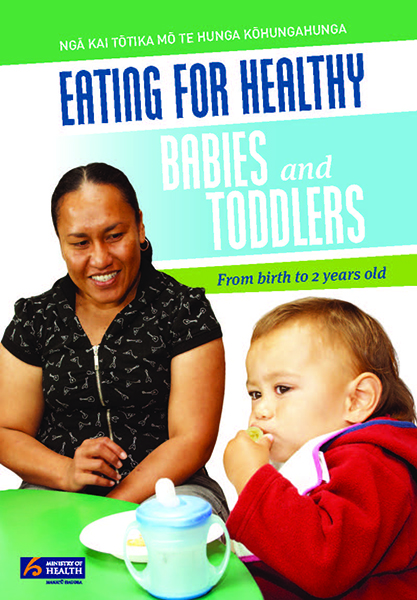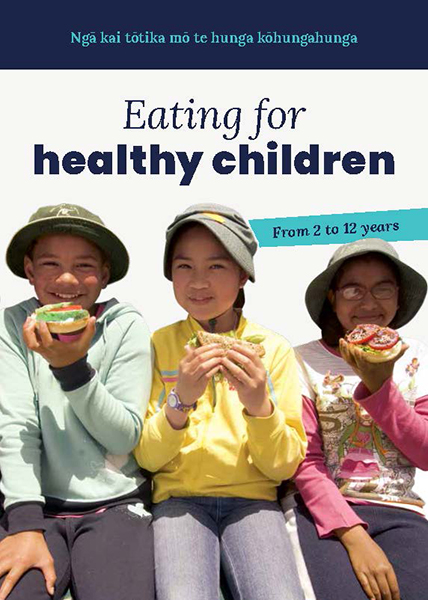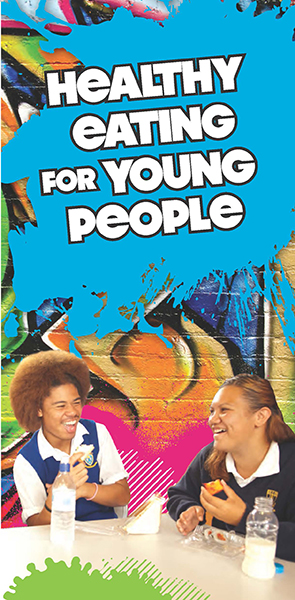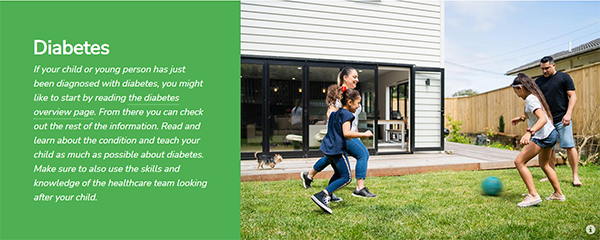Healthy Eating For Children With Diabetes
Healthy Eating For Children With Diabetes
Healthy meal planning is an important part of diabetes management. There is no need for your child or young person to eat special foods or follow a restrictive diet.
Key points about healthy eating for children with diabetes
- healthy meal planning is an important part of diabetes management
- healthy eating for people with diabetes is the same as healthy eating for everyone
- there is no need for your child or young person to eat special foods or follow a restrictive diet
- regular physical activity is also important and benefits people of all ages
What kind of meal planning does my child with diabetes need?
Regular meals and a variety of foods
It is important for tamariki (children) and rangatahi (young people) with diabetes to eat regular meals and a variety of foods as part of their routine eating plan. Most tamariki can enjoy foods from each of the 4 food groups every day, including:
- vegetables and fruits
- breads and cereals
- milk and milk products
- lean meat, chicken, fish and seafood, eggs, legumes, nuts and seeds
Routine eating plan and healthy food choices
Tamariki and rangatahi need to eat enough food, and drink enough fluids, so they can grow and keep active. Having a routine eating plan and teaching your child to make healthy food choices is an important part of diabetes management. This will help your child to keep their blood glucose levels steady and within the target range most of the time.
A dietitian who specialises in diabetes will work out a routine eating plan that suits you and your child. The plan will work in with your child's type of diabetes and their medicines. Each child is an individual and the eating plan that might work best for your family will depend on things like:
- nutritional needs for growth and development
- daily routine
- food preferences
- physical activity levels
- your child's medicine regimen
- any other dietary needs
Most tamariki and rangatahi living with diabetes do not need to follow a ‘special diet’ or restrictive eating plan. There may be exceptions for tamariki who also have other health conditions.
Main nutrients (macronutrients)
Food is made up of 3 main nutrients.
Carbohydrates
These are the best source of energy for the body. Carbohydrates are broken down (digested) into glucose and absorbed into the bloodstream. The body, including the brain and the muscles, uses glucose as a fuel.
Carbohydrates are found in a range of foods.
Breads and cereals
Breakfast cereals, oats, breads, crackers, rice, pasta, noodles, quinoa, couscous.
Starchy vegetables and fruits
Potato, kumara, sweetcorn, yam, parsnips, taro, green banana, cassava, a variety of fruits.
Milk and milk products
Milk, yoghurt, ice cream.
Legumes and lentils
Baked beans, chickpeas, lentils or dahl, split peas, kidney beans, soy beans.
Foods with added sugars
Jam, cakes, biscuits, ice cream, cordials, soft drinks, fruit drinks.
Protein
Protein is a source of energy but its main role in the body is growth and repair. Protein is a building block. It helps in forming muscles, hair, nails, skin and body organs.
Protein is found in a range of foods.
Animal sources
Meat, fish, chicken, eggs, milk, cheese and yoghurt.
Plant sources
Soy protein (such as soy beans, tofu and soy milk), grains (quinoa, oats, barley, etc), nuts and pulses (dried beans, peas and lentils).
Fats
Fats are a very dense form of energy. There are 3 different types of fat: monounsaturated, polyunsaturated and saturated. All these different types of fat contain the same amount of energy in each gram. But they have different effects on our heart and overall health.
Saturated fat
Saturated fat increases total cholesterol by increasing the 'bad' LDL cholesterol. Eat foods that contain a lot of saturated fat in the smallest amounts. Aim to reduce saturated, and choose monounsaturated and polyunsaturated fats where possible.
Sources: butter, cheese, meat fat, ghee, meat products (sausages, hamburgers), full-fat milk and yoghurt, pies, pastries, biscuits, cakes, lard, dripping, hard margarines and baking fats, coconut and palm oil.
Monounsaturated fats and polyunsaturated fats (unsaturated fats)
Unsaturated fats appear to protect against heart disease, by increasing the levels of 'good' HDL cholesterol and helping to reduce your LDL (bad) cholesterol.
Sources: olive oil, avocado and avocado oil, canola oil, nuts (pistachio, almonds, hazelnuts, macadamia, cashew, pecan, peanut, walnuts) and the oils from these nuts. Oily fish, soy bean, flaxseeds and their oil-based margarines and table spreads.
Why are carbohydrates important for my child with diabetes?
Carbohydrate has the biggest impact on blood glucose levels. It is important to include some good quality carbohydrate foods at each main meal (and snacks) to keep blood glucose levels steady. Your dietitian can give you advice about the right amount and type of carbohydrate for your child or young person. Your diabetes healthcare team may teach you to count carbohydrates.
See the KidsHealth page on the nutritional management of type 1 diabetes.
What is the glycaemic index?
The glycaemic index (GI) is a ranking of carbohydrate foods based on how quickly they are digested and their impact on blood glucose levels.
Low GI foods
Some carbohydrate foods are digested slowly, producing a gradual rise in blood glucose levels. These slowly digested carbohydrates (low GI or low glycaemic index) help to keep blood glucose levels steady. They help to provide continuing energy across the day. This can be especially important when your child or young person is active or playing sports.
Low GI foods include:
- wholegrain breads, pasta and unrefined cereals that are high in fibre (such as Burgen®, Holsom's® 9 grain, rolled oats, All Bran®, Special K®, Weetbix®
- rice (such as basmati, Doongara, Uncle Ben's®, parboiled rice)
- legumes and lentils (such as baked beans, chickpeas, split peas, kidney beans, haricot beans)
- dairy with protein (such as milk, yoghurt, low fat ice cream)
- fruits (such as oranges, apricots, peaches, plums, cherries, apples, pears, dried apricots, prunes)
- vegetables (such as corn, kumara, yams, taro, green banana)
High GI foods
Some carbohydrate foods are digested quickly and produce a rapid rise in blood glucose levels. They are called quick release or high GI foods. They can be helpful when blood glucose levels are dropping, during exercise or when treating hypoglycaemia (low blood glucose levels).
Your dietitian can recommend the use of different types of carbohydrates to fit in your child or young person's routine meal plan and activities.
Why is specific dietary advice important for my child with diabetes?
It is important that your child or young person sees a dietitian regularly, as part of the specialist diabetes team. Your dietitian can provide more education and information on the dietary management of your child's diabetes. They can review your child or young person's routine eating plan to support their growth and development.
For more information, see the following KidsHealth pages.
Type 1 diabetes in children - general guidelines on nutritional management.
Type 2 diabetes in children - general guidelines on nutritional management.
New Zealand guidelines for healthy eating by age
The following resources from the Ministry of Health provide lots of good information about food choices and serving sizes for tamariki and rangatahi of different ages.
Eating for healthy babies and toddlers/Ngā kai tōtika mō te hunga kōhungahunga | HealthEd.
Eating for healthy children aged 2 to 12/Ngā kai tōtika mō te hunga kōhungahunga | HealthEd.
Healthy eating for young people | HealthEd.
See more KidsHealth content on diabetes
This page last reviewed 22 March 2024.
Do you have any feedback for KidsHealth?
If you have any feedback about the KidsHealth website, or have a suggestion for new content, please get in touch with us.
Email us now



